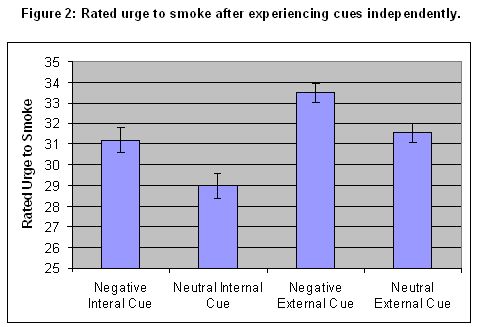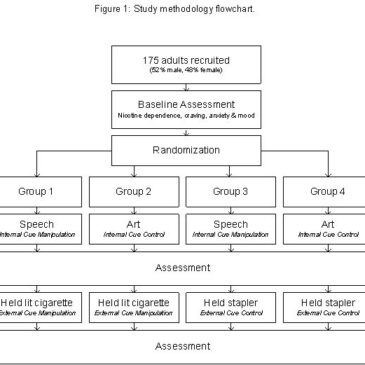Everyday life produces myriad internal and external cues that can increase craving for cigarette smoking. Previous research has shown that both internal (e.g., anxiety) and external (e.g., smoking imagery) cues can increase smoking urges (Carter & Tiffany, 1999; Kassel, Stroud & Paronis, 2003). This issue of ASHES explores the separate and joint effects of external and internal cues on cigarette craving (Litvin & Brandon, 2010).
Methods
- Researchers recruited 175 adults (48% female) from a low-income neighborhood through newspaper advertisements and flyers. All participants reported that they had smoked at least ten cigarettes daily for more than one year.
- The researchers randomized participants into four groups (see Figure 1).
- All participants completed a questionnaire that assessed nicotine dependence, anxiety, and mood at baseline and after each cue manipulation. Participants also rated their urge to smoke on a scale from 0-100.
- To create an internal cue for anxiety, researchers asked members of groups 1 and 3 to prepare to perform a speech.
- Groups 2 and 4 rated art instead.
- Researchers hypothesized that anxiety would trigger smoking cravings by creating an undesirable affect state.
- Participants completed a manipulation check to ensure that anxiety was increased and the manipulation was successful.
- To create a cigarette smoking external cue, researchers asked member of groups 1 and 2 to hold a lit cigarette, but not smoke it.
- Groups 3 and 4 held a stapler instead.
- Researchers hypothesized that exposure to the cigarette would increase cravings.

Figure 1. Stud methodology flow chart. Click image to enlarge.
Results
- Both speech and cigarette-smoking manipulations caused increased levels of smoking craving, Finternal (1, 171) = 6.75, pinternal; Fexternal (1, 171) = 9.16 p < .02, pexternal < .01.
- Two-way Analysis of Variance (ANOVA) showed the sequential experience of negative internal and external cues did not result in more craving compared to the other conditions[1].
- An affect check showed that the internal cue manipulation did not significantly increase anxiety F (1,171)=1.84, p<.02.

Figure 2. Rated urge to smoke after experiencing cues independently. Click image to en
Limitations
- The speech condition did not increase anxiety significantly.
- Participants experienced the cues sequentially, separated by a 20-minute survey, rather than simultaneously
- The order of cues presented to participants was not randomized or counterbalanced.
Conclusions
Negative internal and external cues independently triggered smoking craving. The joint cues did not increase craving more than each cue presented independently. It is difficult to interpret the influence of the speech task, however, as it failed to increase anxiety. Therefore, in this study, we cannot conclude that internal and external cues presented together increase craving more than each presented individually. This and similar research sheds light on the factors that lead people to smoke. Such knowledge can help researchers develop more effective treatments to help people who have quit smoking resist the urge to relapse.
-Daniel Tao
References
Carter, B. L. & Tiffany, S. T. (1999). Meta-analysis of cue-reactivity in addiction research. Addiction, 94, 327-340.
Litvin, E. B., & Brandon, T. H. (2010). Testing the influence of external and internal cues on smoking motivation using a community sample. Experimental and Clinical Psychopharmacology, 18(1), 61-70.
Kassel, J. D., Stroud, L. R. & Paronis, C.A. (2003). Smoking, stress and negative affect: Correlation, causation and context across stages of smoking. Psychological Bulletin, 129(2), 270-304.
What do you think? Please use the comment link below to provide feedback on this article.
[1] No F reported.




